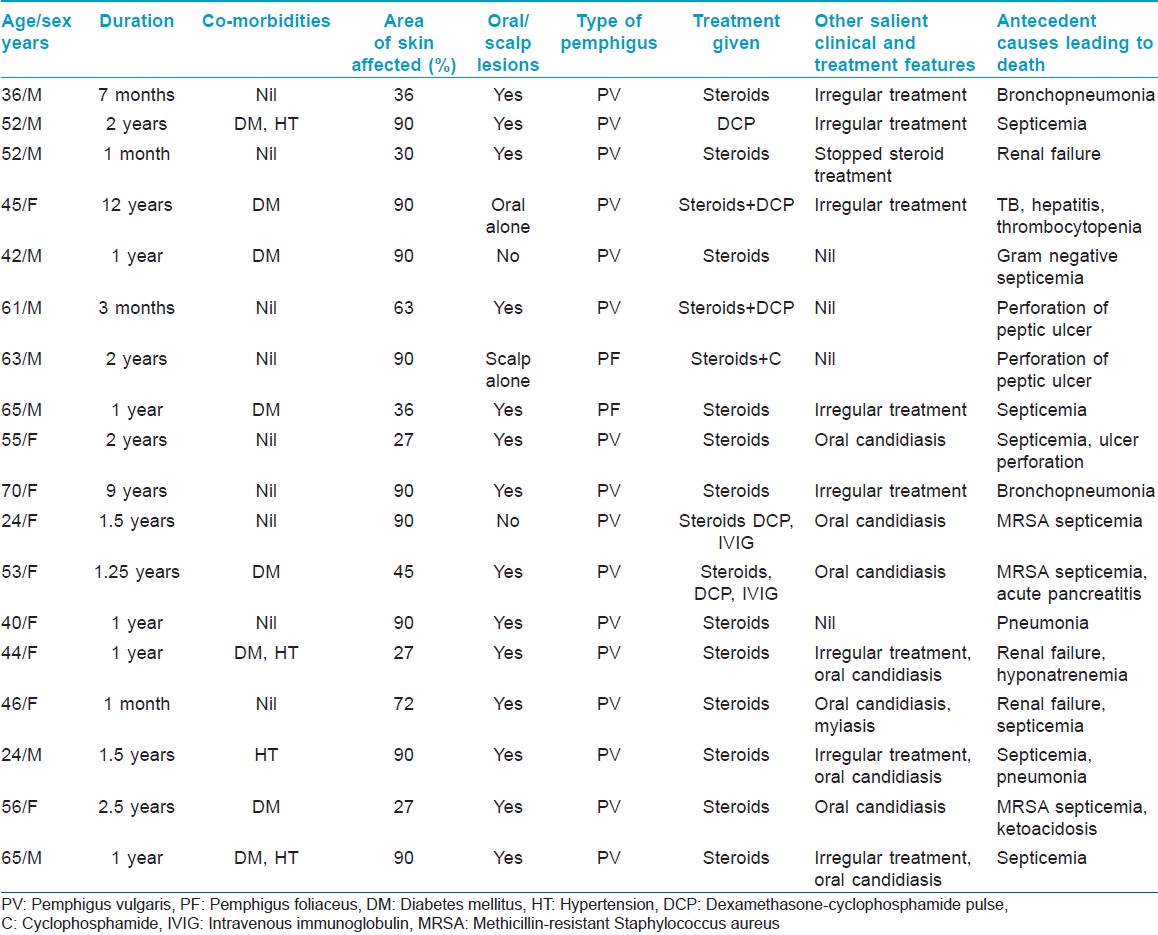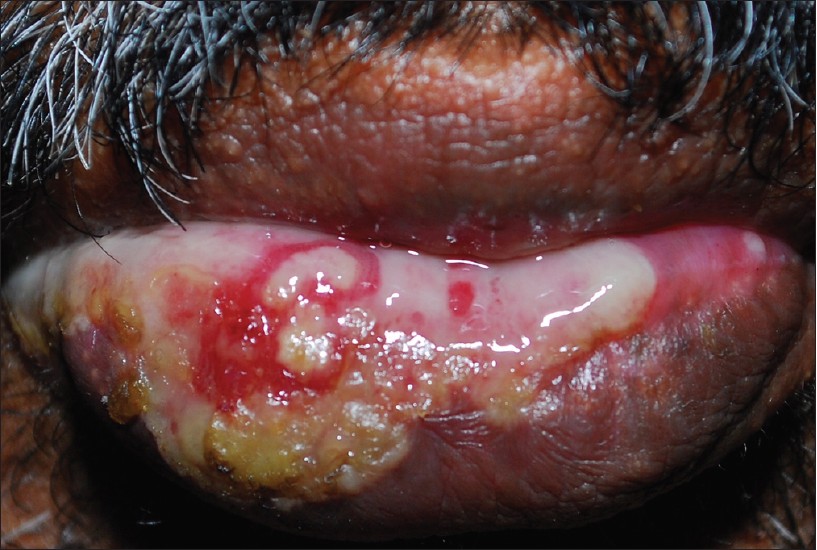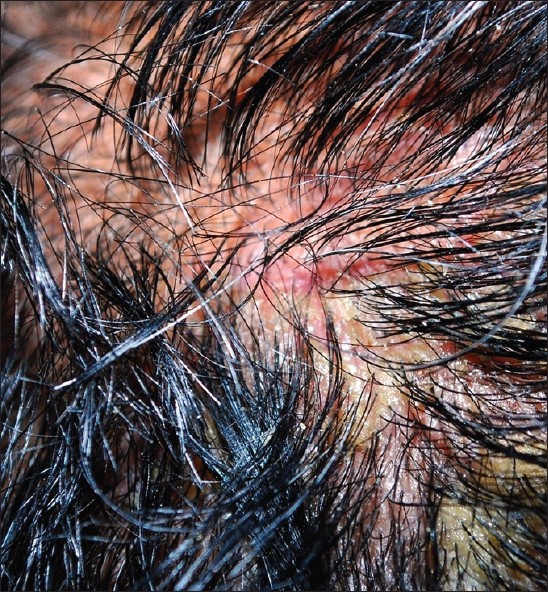Translate this page into:
A retrospective study of mortality of pemphigus patients in a tertiary care hospital
Correspondence Address:
S Pradeep Nair
Department of Dermatology and Venereology, Government Medical College Hospital, Trivandrum - 695 011, Kerala
India
| How to cite this article: Nair S P. A retrospective study of mortality of pemphigus patients in a tertiary care hospital. Indian J Dermatol Venereol Leprol 2013;79:706-709 |
Sir,
Pemphigus vulgaris (PV), an autoimmune vesiculo- bullous disorder, which primarily affects the skin, scalp, and mucous membranes, is potentially a fatal disease. The primary objective of this study was to find the case fatality rate in PV patients and our secondary objective was to elucidate the co-morbidities and antecedent complications which contributed to the death of the patient.
This is a 13-year (2000-2012) retrospective descriptive study done in the department of Dermatology and Venereology, Medical College Trivandrum by obtaining data from the case records of the Medical Records Library. All clinically diagnosed cases of pemphigus confirmed by skin biopsy and direct immunofluorescence and who died during the study period were included in the study. The salient demographic, clinical, treatment, and mortality details are given in [Table - 1].

In the present study, there were 18 deaths from a total of 235 pemphigus patients in a 13 year study period, thus accounting for a case fatality rate of 7.65%. Various other mortality studies range from 4 to 88 deaths. [1],[2],[3],[4],[5] The mortality figures of pemphigus in India compared to their Western counterparts is much less. This could be due to racial factors. [1] PV was the commonest type of pemphigus to cause mortality in this study (88.8%). This is in conformance with other similar studies. [2],[3],[4] The majority of deaths in this study occurred in patients with age more than 50 years (55.5%), similar to other studies. Older age group patients are also more prone for co-morbidities like diabetes and hypertension, which in turn may contribute to the mortality, especially steroid-induced worsening of diabetes and hypertension. [1],[2],[3],[4] In the present study, 50% of the cases had more than 90% body surface involvement. This indicates that when the body surface involvement is extensive, there is a greater chance for mortality. Erosions involving extensive areas of the body in effect, damages the primary barrier function of the skin, making the patients more prone for infections which in turn may lead to septicemia and bronchopneumonia, causing death. Moreover, Savin JA et al., in his study has demonstrated that blister fluid in pemphigus are rich in protein, sodium, potassium, and chlorides and their loss when the blisters ruptures leads to severe electrolyte imbalance which in turn contributes to mortality. [2] The present study showed that mortality occurred more in patients who had scalp and oral lesions (77.7%), as seen in other studies [Figure - 1] and [Figure - 2]. The oral and scalp lesions in PV are the last to heal and are sometimes even resistant to therapy. This may necessitate prolongation of steroid therapy or even up-dosing the therapy to gain remission. Unfortunately, this may contribute to therapy induced complications leading to mortality. [2],[3],[4],[5] However, Kalra et al., has cautioned that concomitant oral herpes and oral cytomegalovirus (CMV) infections may delay the healing of oral pemphigus lesions and early diagnosis and treatment of these infections is mandatory. In the present study, 94.4% of the patients were on systemic steroids at the time of death. Death also occurred in 5 cases of patients who were on dexamethasone-cyclophosphamide pulse (DCP) therapy. In most of the other studies, steroid-induced complications contributed significantly to the mortality of the patients. [1],[2],[3],[4],[5] Prompt and judicious treatment alone is not sufficient, as the present study showed that 50% of the patients who had died were irregular on treatment (missed therapy for more than 1 month). In the present study, 88.8% of the patients died due to disease process and therapy-induced complications, septicemia accounting for 55.5%, followed by respiratory tract infection and peptic ulcer perforation. Septicemia was the commonest cause of death in most mortality studies of pemphigus. [2],[3],[4] Staphylococcus aureus was the commonest pathogen isolated in this study and in three cases Methicillin-resistant Staphylococcus aureus (MRSA) [Figure - 3] was cultured. MRSA infection has very high mortality in immunosuppressed patients. In a resource poor country like India, steroids may be the only available option for most pemphigus patients in the foreseeable future, as expensive alternatives like Intravenous immunoglobulin (IVIG) and the anti CD20 monoclonal antibody, rituximab may be beyond most patients. When treating with steroids alone, judicious acumen should be employed keeping in mind the aforementioned facts.
 |
| Figure 1: Recalcitrant oral lesions of pemphigus with concomitant oral herpes |
 |
| Figure 2: Recalcitrant scalp lesions of pemphigus |
 |
| Figure 3: Crusted plaque of pemphigus colonized with MRSA |
Retrospective studies have inherent weakness and not comparing patients with favorable outcome, is this study′s limitation. Long duration of disease, extensive areas of skin involvement, oral and scalp lesions, and co-morbidities like diabetes contributed significantly to mortality. Irregular treatment and prolonged monotherapy with systemic steroids were other factors causing mortality. Disease process and therapy induced complications like septicemia, pneumonia, and peptic ulcer perforation were the commonest causes of death.
| 1. |
Nair PS, Moorthy PK, Yogiragan K. A study of mortality in dermatology. Indian J Dermatol Venereol Leprol 2005;71:23-5.
[Google Scholar]
|
| 2. |
Savin JA. Some factors affecting prognosis in pemphigus vulgaris and pemphigoid. Br J Dermatol 1981;104:415-20.
[Google Scholar]
|
| 3. |
Huang YH, Kuo CF, Chen YH, Yang YW. Incidence, mortality, and causes of death of patients with pemphigus in Taiwan: A nationwide population-based study. J Invest Dermatol 2012;132:92-7.
[Google Scholar]
|
| 4. |
Baibergenova AT, Weinstock MA, Shear NH. Mortality from acquired bullous diseases of skin in Canadian adults 2000-2007. Int J Dermatol 2012;51:1325-8.
[Google Scholar]
|
| 5. |
Kalra A, Ratho RK, Kaur I, Kumar B. Role of herpes simplex and cytomegalo viruses in recalcitrant oral lesions of pemphigus vulgaris. Int J Dermatol 2005;44:259-60.
[Google Scholar]
|
Fulltext Views
4,651
PDF downloads
2,184





